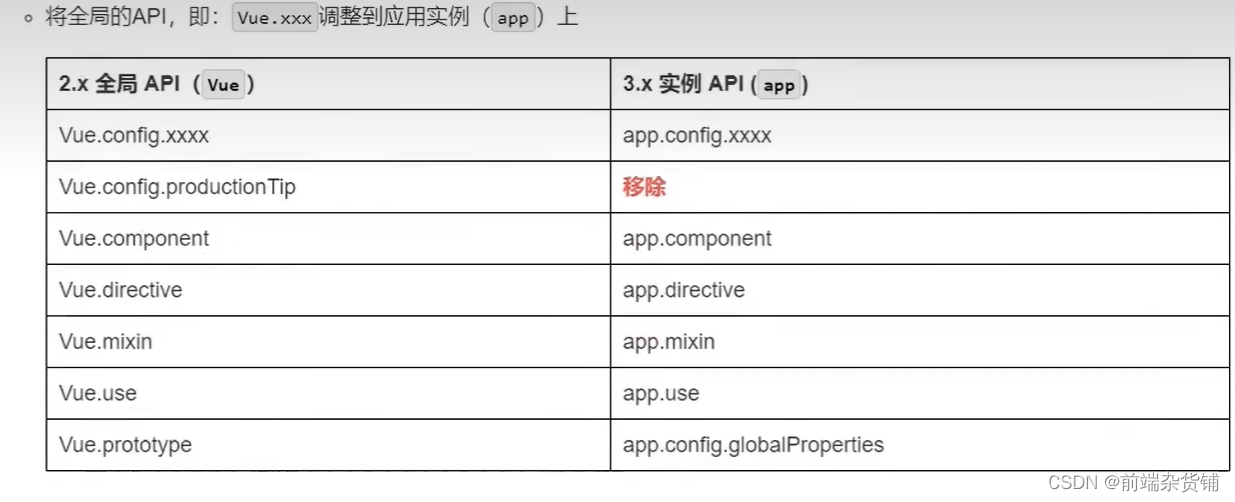系列文章目录
Vue3 —— 常用 Composition API(零)(setup函数、ref函数、reactive函数、响应式、reactive对比ref)
Vue3 —— 常用 Composition API(一)(computed函数、watch函数、watchEffect函数、生命周期钩子)
Vue3 —— 常用 Composition API(二)(hook 函数、toRef 和 toRefs)
Vue3 —— 其他 Composition API(shallowReactive、shallowRef、readonly、shallowReadonly、toRaw、markRaw…)
Vue3 —— 新的组件及一些改变(Fragment、Teleport、Suspense、其他的改变)
Fragment(无需配置)
区别及好处
在 vue2 中:组件必须有一个根标签
在 vue3 中:组件可以没有根标签,内部会将多个标签包含在一个 Fragment 虚拟元素中
好处:减少标签层级,减少内存占用
扫描二维码关注公众号,回复:
14389973 查看本文章


Teleport
什么是 Teleport ?
是一种能够将我们的组件 html 结构移动到指定位置的技术。
实例
App.vue
<template>
<div class="app">
<h3>我是App组件</h3>
<Child />
</div>
</template>
<script>
import Child from "./components/Child";
export default {
name: "App",
components: {
Child },
};
</script>
<style scoped>
.app {
background-color: gray;
padding: 10px;
}
</style>
Child.vue
<template>
<div class="child">
<h3>我是Child组件</h3>
<Son/>
</div>
</template>
<script>
import Son from './Son';
export default {
name: "Child",
components: {
Son }
};
</script>
<style scoped>
.child {
background-color: skyblue;
padding: 10px;
}
</style>
Son.vue
<template>
<div class="son">
<h3>我是Son组件</h3>
<Dialog/>
</div>
</template>
<script>
import Dialog from './Dialog.vue';
export default {
name: "Son",
components: {
Dialog }
};
</script>
<style scoped>
.son {
background-color: orange;
padding: 10px;
}
</style>
Dialog.vue
to = "body",把结构放在 body 里面
<template>
<div>
<button @click="isShow = true">点我弹窗</button>
<teleport to="body">
<div v-if="isShow" class="mask">
<div class="dialog">
<h3>我是一个弹窗</h3>
<h4>一些内容</h4>
<h4>一些内容</h4>
<h4>一些内容</h4>
<button @click="isShow = false">关闭弹窗</button>
</div>
</div>
</teleport>
</div>
</template>
<script>
import {
ref } from "vue";
export default {
name: "Dialog",
setup() {
let isShow = ref(false);
return {
isShow };
},
};
</script>
<style scoped>
.mask {
position: absolute;
top: 0;
bottom: 0;
left: 0;
right: 0;
background-color: rgba(0, 0, 0, 0.5);
}
.dialog {
position: absolute;
top: 50%;
left: 50%;
transform: translate(-50%, -50%);
text-align: center;
width: 300px;
height: 300px;
background-color: greenyellow;
}
</style>
实现效果:
Teleport
Suspense
作用
等待异步组件时渲染一些额外内容,让应用有更好的用户体验
使用步骤
- 异步引入组件
- 使用 Suspense 包裹组件,并配置好 default 与 fallback
App.vue
- import 引入组件
- 用 Suspense 包裹组件,default 里面为默认的值,fallback 里面为没加载出来的提示
<template>
<div class="app">
<h3>我是App组件</h3>
<Suspense>
<template v-slot:default>
<Child />
</template>
<template v-slot:fallback>
<h3>稍等,加载中...</h3>
</template>
</Suspense>
</div>
</template>
<script>
import {
defineAsyncComponent } from "vue";
const Child = defineAsyncComponent(() => import("./components/Child")); //异步引入
export default {
name: "App",
components: {
Child },
};
</script>
<style scoped>
.app {
background-color: gray;
padding: 10px;
}
</style>
Child.vue
用 Suspense 和异步组件配合,也可以在 setup 里返回一个 Promise 实例
<template>
<div class="child">
<h3>我是Child组件</h3>
{
{
sum}}
</div>
</template>
<script>
import {
ref} from 'vue'
export default {
name: "Child",
setup(){
let sum = ref(200)
return new Promise((resolve)=>{
setTimeout(()=>{
resolve({
sum})
},1000)
})
}
};
</script>
<style scoped>
.child {
background-color: skyblue;
padding: 10px;
}
</style>
效果如下:
suspense
全局 API 的转移

其他改变
- data 选项应始终被声明为一个函数
- 过渡类名的更改 v-enter ==> v-enter-to
- 移除 keyCode 作为 v-on 的修饰符,同时也不再支持 config.keyCodes
- 移除 v-on.native 修饰符
父组件中绑定事件
<my-component v-on:click="xxx">
子组件中声明自定义事件
export default{
emits: ['click']
}
- 移除过滤器(filter)
不积跬步无以至千里 不积小流无以成江海
点个关注不迷路,持续更新中…